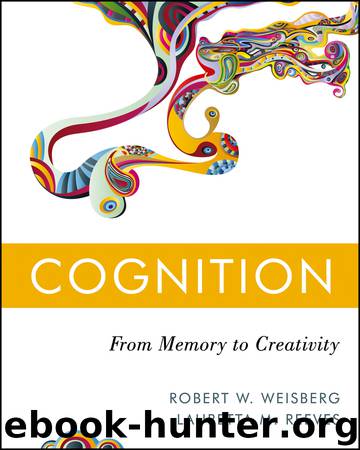Cognition by Robert W. Weisberg & Lauretta M. Reeves

Author:Robert W. Weisberg & Lauretta M. Reeves
Language: eng
Format: epub
Publisher: John Wiley & Sons
Published: 2013-01-27T16:00:00+00:00
The Cree and McRae (2003) analysis explains some of the neuropsychological trends in category-specific impairments based on distribution of types of knowledge features (similar to the basis for the sensory/functional distinction proposed by Warrington and McCarthy (1983), but using a wider array of features). Their model thus provides a more complicated multidimensional approach by which to analyze and explain the patient data.
Summary of Neuropsychological Findings
Our discussion of the neuropsychological mechanisms underlying representations of concepts has centered on the finding that patients sometimes show deficits in dealing with living versus nonliving objects. In examining this finding, we began with the idea that the distinction between living and nonliving things is directly represented in the brain. However, further consideration of research results led to a very different idea: that the living versus nonliving deficit is a secondary result of a more primary difficulty, an inability to deal with visual versus functional characteristics of objects. This analysis is important for several reasons. First it alerts us to the possibility that concepts are not necessarily organized so that separate classes are represented in different parts of the brain. This conclusion is also consistent with the model of semantic memory proposed by Burgess (1998; Lund & Burgess, 1996, 1997; see also Landauer et al., 2007), which assumes that organization in semantic memory depends only on the similarities between the contexts in which items appear, analogous to assuming that taxonomic category structure is secondary to aspects developing out of our interactions with the objects. It is also consistent with Barsalou's analysis of the flexible nature of the representations that we construct to think about concepts. Second, the Farah and McClelland (1991) study is a striking example of how one can coordinate results from neurocognitive studies with those from more traditional cognitive psychology and computer models of cognition in order to test hypotheses. Cree and McRae (2003) have developed a multidimensional model that best characterizes the complexity of the patient data, based on which cluster (and at which level) their impairment occurs (see also Humphreys & Forde, 2001).
Download
This site does not store any files on its server. We only index and link to content provided by other sites. Please contact the content providers to delete copyright contents if any and email us, we'll remove relevant links or contents immediately.
The Art of Thinking Clearly by Rolf Dobelli(10326)
Mindhunter: Inside the FBI's Elite Serial Crime Unit by John E. Douglas & Mark Olshaker(9265)
Change Your Questions, Change Your Life by Marilee Adams(7687)
Nudge - Improving Decisions about Health, Wealth, and Happiness by Thaler Sunstein(7659)
Mastermind: How to Think Like Sherlock Holmes by Maria Konnikova(7279)
The Power of Now: A Guide to Spiritual Enlightenment by Eckhart Tolle(5681)
Men In Love by Nancy Friday(5194)
Altered Sensations by David Pantalony(5071)
Factfulness: Ten Reasons We're Wrong About the World – and Why Things Are Better Than You Think by Hans Rosling(4715)
The Confidence Code by Katty Kay(4221)
Thinking in Bets by Annie Duke(4186)
Man and His Symbols by Carl Gustav Jung(4096)
The Worm at the Core by Sheldon Solomon(3452)
Why Buddhism is True by Robert Wright(3424)
Liar's Poker by Michael Lewis(3416)
Three Women by Lisa Taddeo(3393)
The Inner Life of Animals by Peter Wohlleben(3285)
Descartes' Error by Antonio Damasio(3248)
How Music Works by David Byrne(3234)
